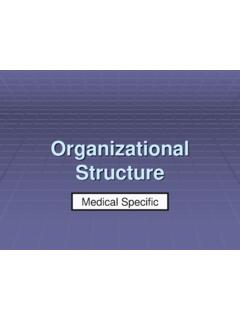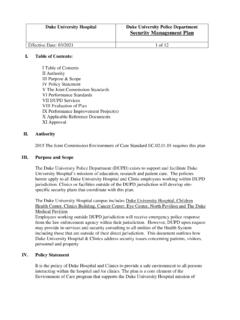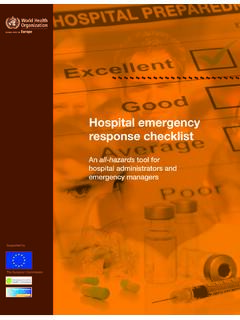Transcription of Hospital Bed Management - Infosys - Consulting
1 VIEW POINTA bstractThough Bed Management is a core operational activity in all hospitals, many hospitals have problems with it. This seemingly simple activity is anything but that. Few institutions have complete visibility of this process as it weaves its way through the organization and fewer still have a means of measuring the performance of the activity that results in the availability of a bed. Optimizing Bed Management is critical to the efficient functioning of any Hospital . This paper proposes a way to analyze, control and optimize this Management OPTIMIZATION- Dr Ramachandran Balaji, Mark BrownleeBed Management - Not As Simple As It SeemsBed Management is a background activity in hospitals that few consciously notice - at least not until something goes wrong.
2 Inefficient, or worse, ineffective Bed Management is the bane of hospitals all over the country, bringing in its wake myriads of problems for patients, nurses, physicians, and many hospitals, Emergency Rooms (ER) and admission offices are often overcrowded with patients waiting for rooms. This forces physicians to move patients around or to start using competing local hospitals. Sometimes, patients must be accommodated in halls. At other times, poor Bed Management puts valuable ER rooms out of use, leading to treatment limitations for critically ill patients. In all these scenarios, patient and physician dissatisfaction is the immediate result, not to speak of a long term decrease in admissions. At times, the very safety of patients is at risk.
3 While the exact problems and their results can vary, the fact remains that these problems are automated support can help in efficient Bed Management , the key to any real improvement lies with workflow complexity and operational performance. While staff performance plays a big role, it is process design and Management - or the lack of it - that needs to be tackled on a priority Management is an operation in constant evolution which is usually not controlled at the process level. Typically, managers are faced with performance issues that are inwardly focused within their groups. But given the complexities of Hospital operations today, all operational areas are interrelated. Thus, any significant improvement requires a fresh perspective - a crossfunctional or process view.
4 In this view, the entire function of Bed Management is open for review and Management and changes, if any, must be incorporated into the work and workflow of the department. This requires a two-level approach to Operational Management and Optimization: Process-level Management and Optimization Followed by Operational Workflow Management and Optimization within the departmentUnfortunately, few organizations have this level of operational visibility or control. We have found that for most organizations, process maps are at the internal organization level and really reflect workflow, not process (which is cross-organizational). We have also found that few organizations pay much attention to their operational maps once they are created and fewer still keep them upto- date or use them to guide improvement.
5 Without this process-level view, work can only be improved at the local workflow level and the overall process cannot be improved or optimized. For efficient Bed Management , the two-level approach is absolutely critical. It is important that the entire process is optimized as a first step. Then, the parts of the process that lie within each organization should be operationally process-level view of Bed Management provides insights into all the activities of different groups - from Admission/Discharge/Transfer (ADT) to House-Keeping to ER and so on - and how these activities flow. Maps of these activities comprise work steps from all organizations even remotely involved in the process. As such, it is important that any map be cross-referenced at the step level with the organization that performs the step.
6 As the flow of information and activity is mapped, the steps take on a context that shows decisions, rules and relationships. In any process, application systems have a significant impact on productivity and downstream work. But in most hospitals, the systems support only part of the Bed Management process. This causes process disconnects as the work and the systems that support the work are often poorly tied. While this is often a workflow problem rather than a systems problem, it can be both. These disconnects happen because of hidden manual and automated components that often fail to work in close sync to offer a smooth working providing application support at the points it is used ( touch points ), the Management can easily view the impact - or lack of it - at all steps and at an overall level.
7 This association of step, work, and support can be augmented with data needs, use, flow, and transform information to provide a firm understanding of the patient volume information and problems can now be added to the process maps to complete the picture of the operation. Once the Hospital enters this information into a Business Process Management (BPM) tool, it will be in a position to: Modify the process Define process Management activity Generate process Management applications Begin to control the process s evolutionThe process can then be analyzed and operational break points defined. Break points are places in the process where the activity breaks down or where the clinical quality is affected. By determining the factors that cause these problems, the Management will be able to describe them in terms of characteristics.
8 These characteristics can then be viewed as a grouping of factors that can be associated with one or more work steps and measured. This is the driver for real-time dashboard support for the Document 2018 Infosys LimitedExternal Document 2018 Infosys LimitedDashboards Show Real-time ActivityOnce the process is understood and the break points identified and defined in a way that lets Management measure operational flow, a comprehensive dashboard that shows real-time activity must be put in place. This dashboard should measure activities in all departments involved in the Bed Management process and show workload or delays, etc. Alerts should be included as the backlog or time approaches set limits, with drill down information on what is causing the alert.
9 Management can then take pre-emptive action based on such information. Over a given time, Management is also able to define trends and operating scenarios that set the stage for challenge of setting up the dashboard has nothing to do with technology. There are several good dashboard products that can do the job. Interfacing is a challenge, but that can be handled with brute workforce. The real issue that can make or break the operational Management and improvement effort is an understanding of what to measure. This is an area that is most often not given the attention it don t need to overburden managers or staff with meaningless monitoring or performance measurements because the key to performance Management is the control of activity at the break points.
10 These are the points where things come together or delays occur. They are not necessarily points where the problem actually occurs. Those are defined in the characteristics that describe what can go wrong to cause a problem at the break point. While the dashboard should provide detailed drill down information for Management to take corrective action, the monitoring must be at key activity completion dashboards can thus track breakpoint information against defined criteria with limit and aging logic, and provide alerts. Using a drill down for alerts, the dashboard shows the exact cause of the problem. Defining Bed Management s ProblemsWith the process maps in place, the business rules defined and the dashboards in place, Management can now watch the process in real time and take corrective action before a problem occurs.
















